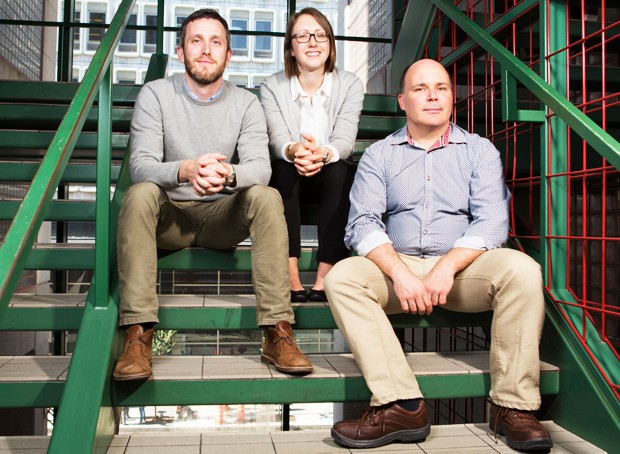Jackpot for researchers — from geospatial data to 500-year-old manuscripts
 From left: scholarly communications librarian Geoffrey Little, special collections librarian Alexandra Mills and geospatial and data services librarian Alex Guindon are in the business of making information as readily available as possible and helping people manage their own information. | Photo by Concordia University
From left: scholarly communications librarian Geoffrey Little, special collections librarian Alexandra Mills and geospatial and data services librarian Alex Guindon are in the business of making information as readily available as possible and helping people manage their own information. | Photo by Concordia University
As the end of term draws near, it’s a busy time of year at Concordia’s libraries. There’s no better place to get started on research for a final paper, or prepare for a challenging exam. This week, in our ongoing series about the libraries, we explore their extensive digital and special collections.
Concordia’s geospatial and data services librarian, Alex Guindon, fields many requests from students and faculty looking for data sets to use in their research.
“There are a lot of existing data repositories. Some of them are institution based, some are subject specific and others contain government data. The number is growing fast. I can point to those data sets, depending on students and researchers’ needs,” he says.
Guindon spends a lot of time tracking down useful new resources, too. Recently, for example, while helping a graduate student, he discovered that Libraries and Archives Canada had digitized a large amount of early census data. “Until recently, researchers would have had to go to the library and explore the volumes one by one, which would be pretty tedious and complicated.”
On the flip side, Guindon is also working to help Concordia’s researchers manage their own data sets. Currently, he is developing a research-data management guide that will provide best practices for data documentation, storage and dissemination.
“As a library, we're in the business of making information as readily available as possible. But we’re also here to help people manage their own information as best as they can.”
The explosion of newly-available data resources is only one aspect of the digital revolution sweeping through the library world.
“Libraries are quickly moving from being places centred around their physical collections to being information hubs and repositories for all kinds of digital collections. It’s fun because it’s challenging, and it’s moving fast. I learn about all kinds of stuff I never thought I would use,” says Guindon.
The full Spectrum
Geoffrey Little, scholarly communications librarian, agrees: “Our role is becoming more and more one of curation. The kind of work that Alex does, and that I do with Spectrum, for example, it’s not so much helping someone to find a book or an article; we’re now dealing with thousands of files and an incredible amount of data to make sense of.”
Spectrum is Concordia’s online open-access research repository. It houses more than 2,000 digital documents, including conference papers, articles and the official copy of record of all theses and dissertations published by the university’s graduate students. It’s searchable by author, department and document type.
Spectrum is a key component of the library’s digital collection and a driving force in its campaign for open access, Little explains. “It’s noble and worthwhile, because it’s making information available to a wide audience,” he says, adding that it also increases the visibility of Concordia’s researchers, since it’s indexed by Google.
Subscription-based, primary-source databases are another important component of Concordia’s digital collection. And though these resources, such as the recently purchased New York Times online archive from 1851-2010, are expensive, they’re also in high demand. “Even undergraduate students are now expected to do more work with primary sources because there’s so much more available now,” says Little.
Special Collections
Of course, many primary resources and rare documents are not available in digital form. Some are so rare that they have to be kept in the library’s special collections, and can only be consulted onsite.
In a cool, climate-controlled storage vault in the Vanier Library, special collections librarian Alexandra Mills shows off the university’s oldest book, an illuminated, hand-printed manuscript called The Book of Hours. It dates from 1450, the same year Johannes Gutenberg is believed to have invented the printing press in Europe. “Look at how intricate and beautiful it is. Every page, done by hand,” Mills says, carefully opening the pages.
“This is a beautiful object that we just got, says Mills, holding up a heavy, rectangular artists’ book, called Rose Désarroi. One of only 11 copies made, the book contains an unpublished text by Denise Desautels and digital prints by Bonnie Baxter, a part-time instructor in Concordia’s Department of Studio Arts.
On a set of shelves at the other end of the room is the university’s extensive Irving Layton collection, which includes dozens of tapes and audio reels of the famed poet’s readings. “Those have been digitized, because they’re very, very fragile,” Mills explains. But even though they’re digitized, for copyright reasons, they can still only be consulted by visiting special collections.
“Traditional special collections can't be browsed, because they're so rare and unique, fragile or sensitive in some way,” Mills says. The items are consulted in-house in our reading room, and generally there's a staff member around to help to answer any questions about reproductions or copyright, and stuff like that.”
The mission of Concordia’s libraries is to “provide the university community with the information resources and services fundamental to learning and the pursuit of knowledge.”
Staying up to date with online offerings, expanding Concordia’s digital and special collections, and ensuring that the university’s researchers know how to manage their own valuable data are all important aspects of the library’s mission.
As Little points out, that mission is tied closely to the strategic direction of the university as a whole, which is to promote innovation and excellence in education, research, creative activity and community partnerships.